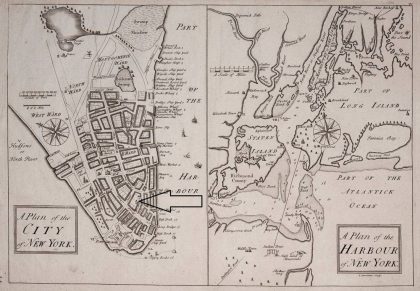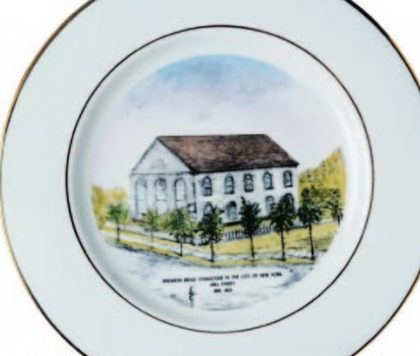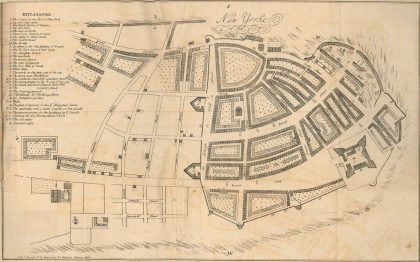Seen & Heard: A marker for the first synagogue in North America
This was originally going to be a couple sentences in Seen & Heard, but the congregation’s story is so interesting, and the art is so cool, that I had to add a bit more. If you get into it too, the history on the synagogue’s website is a good read.
The Lower Manhattan Historical Association will host a ceremony on Monday, April 8, at 12:30p, for the co-naming of South William Street as Mill Street Synagogue/Seixas Way. The designation honors the first synagogue built in United States, constructed in 1730, as well as Rabbi Gershom Mendes Seixas, who was instrumental in building New York’s Jewish community during the colonial era. The ceremony will be held at the southeast corner of Broad and South William, to be followed by the unveiling of the new street sign at intersection of South William Street and Mill Lane. This is the first marker of what really is a huge piece of American and Jewish history on the site.
The Mill Street Synagogue once stood at what became 26 South William – now an Icon parking lot. The congregation itself – Shearith Israel, the Spanish and Portuguese Synagogue in the City of New York – was actually founded in 1654 and was the ONLY synagogue in the city until 1825. The little Mill Street Synagogue was torn down in 1818 and a “big” one that could seat 167 was built to accommodate the growing Jewish population in the city; that was then left behind for a new synagogue on Crosby Street, a closer walk for most folk on shabbat. The synagogue then just followed its members uptown: to 19th Street in 1860 and to 70th Street in 1897, where it is today. This last one was built by Louis Comfort Tiffany. It’s gorgeous. (And its “little synagogue” uptown has much of the furnishings from the original Mill Street location, including torah scrolls that were desecrated by British soldiers during the Revolutionary War.)
As for Seixas, this from the historical association’s write up: “In 1766, Gershom Mendes Seixas became the hazzan of Congregation Shearith Israel, which until the 1820s was the only Jewish congregation in the city. Although not formally an ordained rabbi, Seixas served as the religious and spiritual leader of New York City’s Jewish community for the next 50 years. In doing so, he helped set the tone for how the Jewish community was to integrate into and become part of American society.”















… and presumably this is Synagogue is associated with the second oldest cemetery in New York, located just east of Tribeca.
https://shearithisrael.org/content/chatham-square-cemetery
https://en.wikipedia.org/wiki/First_Shearith_Israel_Graveyard
A bit about who the early American Sephardi who would have worshiped there were, and how they came here. The Portuguese exported the Inquisition to all of their colonies.
The first Jewish families to arrive in the colony of New Amsterdam disembarked from the Ste. Catherine in early September 1654. These six men, seven women and ten children – Dutch citizens – were fleeing Brazil, an embattled Dutch colony that was increasingly being overtaken by Portugal – and coming under the Portuguese Inquisition, which promised torture or death to Jews living in its territories.
Governor Peter Stuyvesant was furious. The new colonists were “enemies and blasphemers” he wrote to the Dutch West India Company, part of a “deceitful race” and would “infect and trouble this new colony”. The governor demanded they leave forthwith, on the next outbound vessel.
But these bedraggled, penniless newcomers refused to be cowed. They too wrote urgent letters to the authorities in Holland, pointing out that they were “confirmed burghers” of the Netherlands, just like “all the other inhabitants of these lands” and demanded their right to live in the colony. For over a year, these 23 Jews and Governor Stuyvesant waited urgently for a reply that would determine the future of Jewish settlement in North America.
Finally, in April 1655, a letter came from Amsterdam: forbidding Jews from the colony was “unreasonable and unfair”. Conditions were put upon the Jews that weren’t demanded of other colonists – they were barred from ever receiving charity from non-Jews – but their safety was ensured. These Jewish colonists established Shearith Israel – the first synagogue in Colonial America – and the oldest surviving congregation in the United States….